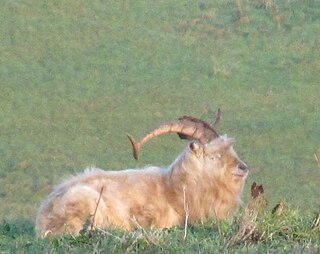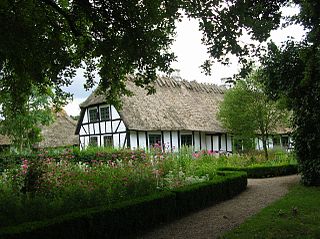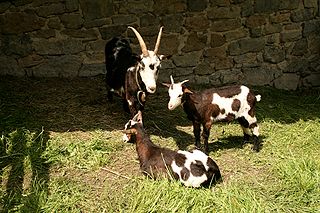The Swedish Landrace (Svensk Lantras) goat breed from northern Sweden is used for the production of milk, which is used to make types of goat cheese.

A landrace is a domesticated, locally adapted, traditional variety of a species of animal or plant that has developed over time, through adaptation to its natural and cultural environment of agriculture and pastoralism, and due to isolation from other populations of the species. Landraces are generally distinguished from cultivars, and from breeds in the standardized sense, although the term landrace breed is sometimes used as distinguished from the term standardized breed when referring to cattle.

The Africanis is a landrace of dogs that occurs across southern Africa.

The Spanish goat, also called the brush goat or scrub goat, came originally from Spain via Mexico to the USA. It is now a meat and brush-clearing type found widely in the United States. In the Southeast and elsewhere, they are often referred to as "wood" (Florida), "brush" or "briar", "hill" (Virginia), and "scrub" goats. Until recently, these goats were kept mainly for clearing brush and other undesirable plant species from pasture lands. The boer goats have overtaken Spanish goats for meat in the 1980s.
The American Landrace is a medium to large breed of domestic pig, white in color, with long bodies, fine hair, long snouts, and heavy, drooping ears. They are bred for pork production

The Bilberry goat is a breed of feral goat which is believed to have lived in one herd on Bilberry Rock in Waterford City in the south of Ireland for hundreds of years.

The Funen Village is an open-air museum located in the neighborhood of Fruens Bøge in Odense, Denmark.

The Danish Landrace is a Danish breed of dairy goat.

The Dutch Landrace is a traditional Dutch breed of domestic goat. It has been known in the Netherlands since the seventeenth century, and was formerly numerous there. It came close to extinction in the 1950s, but was saved by cross-breeding with unrelated goats, and by 2020 numbered over 2000 head.
The Dutch Toggenburg goat breed was developed in the Netherlands from crosses between Dutch Landrace goats and the Toggenburg goat. It is used for the production of milk.

The Finnish Landrace, also called the Finngoat, is a landrace breed of goat originating in western Finland. The breed can come in a variety of colors but is usually grey, pied, or white, and both horned and polled individuals occur. Finnish Landrace goats are typically used for milking, as there is not a strong tradition of goat meat in Finnish cuisine, unlike in southern Europe. Finngoats are the only breed of goat native to Finland, and originate from native goats crossed with other European imports, especially from Switzerland.

The Tauernscheck goat breed from Austria is used for the production of milk. It is a very rare breed derived from the Austrian Landrace and Pinzgauer goat breeds.
A landrace is a type of domestic animal or plant adapted to the natural and cultural environment in which it originated, with minimal selective breeding. Some have "landrace" in the names:
The Swedish Landrace is the leading breed of pig in Sweden. They have heavy drooping ears and a white coat. The Swedish strain of the Landrace pig originated from importations from neighboring countries, particularly Denmark. The Swedish Landrace have attracted attention in the United States and other nations in recent years.

The British Landrace is a British domestic breed of pig and one of the most popular in the United Kingdom. It is white with heavy drooping ears that cover most of the face and is bred for pork and bacon. The breed originated in the 1949 importation of 12 landrace pigs from Scandinavia — four boars and eight gilts. In 1950, the British Landrace Pig Society was formed and it opened a herd book for the first offspring born from the imported 12. They created the first pig testing scheme with a testing station at the village of Stockton-on-the-Forest in North Yorkshire.

The Icelandic goat, also known as the 'settlement goat', is an ancient breed of domestic goat believed to be of Norwegian origin and dating back to the settlement of Iceland over 1100 years ago. This breed of goat was on the verge of extinction during the late 19th century, but recovered prior to World War II, only to precipitously decline again. As of 2003, there were 348 goats in 48 flocks distributed throughout most parts of Iceland. At the end of 2012, the herd had increased to 849. Since this breed has been isolated for centuries, the Icelandic populations are highly inbred. The Icelandic goat is very rare outside its native land. Under its coarse, long guard hair, the Icelandic goat has a coat of high quality cashmere fiber. Icelandic goats are kept mainly as pets and their economic potential for meat, milk, cashmere and skin production remains to be explored. The Icelandic goat is currently of little economic value.
Danish landrace or Danish Landrace can refer to any of the following varieties of domestic livestock from Denmark, some of them landraces, some standardized breeds developed from landraces:

The British primitive goat is a landrace of domestic goat native to Great Britain and Ireland, and is the original goat of the region. It is considered a rare breed, existing as several, isolated feral herds, as some captive populations in zoological parks and nature reserves, and breeding stock on some private farms operated by groups of rare-breed enthusiasts. As few as 1,200 individual British primitives may remain. The variety is also referred to as the British native goat, the old British goat, the old English goat or the British landrace goat, among more specific names It descends from the earliest goats brought to the region in the Neolithic era, around 3,000 BCE. It is classified in the Northern breed group of goats. A population in Northumbria is sometimes referred to as the Cheviot goat. The British primitive is among the foundation stock of some modern standardised breeds, including the Anglo-Nubian goat. The breed is comparatively small, with commensurately low milk production. It is hardy and wiry haired, adapted to rough terrain and weather, and able to subsist and breed on its own without human intervention.
Swedish Landrace may refer to:
Dutch Landrace may refer any of at least the following breeds of livestock from the Netherlands:
West African dwarf may refer to